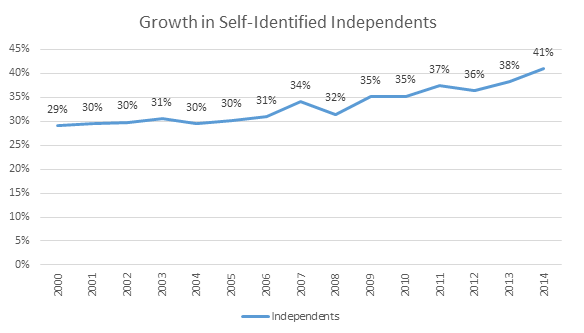Reaching them is important, but not necessarily easy
There are two things I want to do in today’s post. First, point you all to the Pew Research Center’s political polarization report, and their political typology, released last month, in case you haven’t seen these yet. Both are full of great data.
Second, I wanted to pull out some of the data on political independents to talk about, since a larger and larger portion of the country identifies as politically independent, and with the mid-term elections coming up, this group is, as usual, a hot topic of discussion. But neither of the two main stories told about this growing voting bloc – that they all hold moderate views somewhere in between that of Republicans and Democrats, or the more current political-science-based thinking that independents are really only “partisans in disguise” tells the whole picture.
Here are five take-aways about independents from the Pew data.
1. There are lots of them. More and more Americans decline to identify with either party. In this year’s Pew study, 41% call themselves independent – up more than 10 percentage points from a decade ago, and more than identify as Democrats or Republicans.

2. They are not really “in the middle.” Most independents lean toward one party or the other, and issue by issue, the views of these leaners are often very close to those of committed partisans. For example, on gun control, 66% of Democratic-leaning independents say controlling gun ownership is more important (almost matching the 69% among true Democrats), while 72% of Republican-leaning independents say protecting gun rights is more important, along with 76% of true Republicans. So in this way, the “closet partisan” theory makes sense.
3. But they are less politically engaged. One main area where you see a difference between true partisans and independents with a partisan-lean is in their political participation. Only 41% of self-identified independents say they always vote, compared to 61% of self-declared Republicans and 55% of Democrats. A quarter (25%) have contributed money to a political candidate, compared to 39% of Republicans and 34% of Democrats. Even those who lean toward one or the other party are less likely than true partisans to vote and make political contributions.
4. They tend to be more negative about politics in general. Republican-leaning independents, for example, have very negative views of the Democratic party (78% unfavorable), but are not very enthusiastic about the Republican party either (40% have unfavorable views). They are less likely than their partisan counterparts to have positive views of the media – so 49% of Democratic partisans see MSNBC positively, compared to only 38% of Democratic leaners, and Republicans and Republican-leaning independents show a similar pattern regarding Fox News.
5. But they want to be more open to other ideas. On the flip side, independents are more likely to express openness to people who do not share their views. Democratic- and Republican-leaning independents are less likely than their more partisan counterparts to say they want to live in a community where most people share their political views or religious beliefs, less likely to object to someone in their family marrying someone of the other party, and less likely to say that most of their friends share their political views.
This starts to paint a picture of what distinguishes self-identified independents from those who do connect with a political party, and it reflects what I have observed about this group over the years. Independents, regardless of their which party they lean more toward, tend to be dissatisfied with politics as it operates today. They are skeptical of the political system and doubt that it will produce outcomes that satisfy them. In focus groups I have often seen independents complain about being turned off by what they perceive as “negative” messages. They are often less tuned into the details of whatever political conflict is consuming the day.
Taken together, the data suggest that reaching independents is not as easy as moving toward some middle ground that they supposedly occupy, or even as easy as motivating “your” independents the same way you would your base. To reach its portion of this group, each party has to overcome both apathy and skepticism. Democratic-leaning independents are younger, lower-income, and less white, all groups less likely to vote, which ups the challenge even further. But given the pace at which Americans are dissociating themselves from partisan identity, it’s not one that can be ignored.



